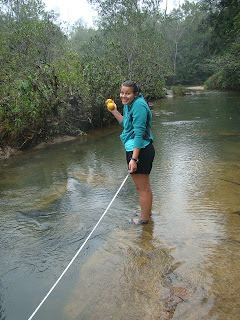Belize-
Stream Ecology encouraged us to learn about the importance of fresh water! Especially, to discuss our responsibility towards streams, given the fact that streams are so important for supporting life and yet make up a small percentage of the total amount of fresh water on earth!
With this in mind, we headed out to the field to discover for ourselves what the water quality is like in Belize’s flowing streams.
Our first day in the field involved learning how to assess the habitat quality of the streams, as well as collecting organisms for a biological survey and testing for chemical variables. A highlight of the day was visiting an impressive cave with a stream flowing through it. Our professor, Mike Guebert from Taylor University, made sure we appreciated the cave for more than it’s beauty, but also for a rare geological feature found inside! The cave is a limestone ceiling which sits directly on the granite bedrock of the stream basin; it is unusual to see two types of rocks, formed over a 100 million years apart, sitting right on top of each other!
Thanks to Ashley Rosenberger of CCSP, we all learned to find and identify intriguing macroinvertebrates that live in streams. The most commonly found macroinvertebrates are insect larva which are so important to the health of streams and can tell us a lot about the water quality of the stream!
On our final fieldtrip we discovered more amazing streams- clear, rushing streams with fast riffles and deeper pools where we could watch cichlid fish swimming, and where we swam too! We enjoyed the bubbling water as we took our water quality data. To end the day we headed to Five Blues, a national park which has a beautiful blue lake, surrounded by a limestone landscape called Karst. After hiking through the thick forest surrounding the lake, the water was refreshing!
At the end of the week students analyzed the stream quality data and presented their findings. While learning all week that the health of a stream is determined by the health of all the land that drains into that stream (the watershed), we began to wonder how healthy the streams and rivers back home are, and what we can do once we return home to ensure a healthy watershed!





No comments:
Post a Comment